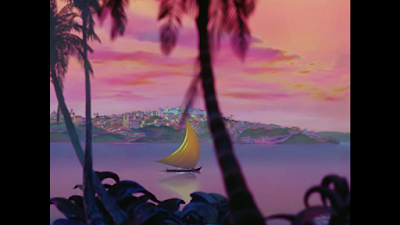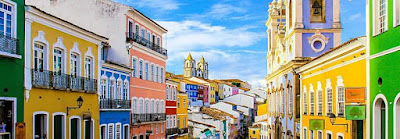Se você me perguntasse qual o meu lugar favorito do mundo inteiro, eu responderia sem pestanejar: o estado da Bahia. É um lugar para o qual eu estou sempre voltando, e onde um dia ainda hei de morar. Na Bahia tudo é fantástico: as praias, a comida – o acarajé – e, claro, as pessoas. A bela Bahia foi mostrada em diversos filmes, incluindo aí uma adorável animação: a bem intitulada “Você Já Foi à Bahia?” (1944), de Walt Disney.
If you asked me which is my favorite place in the entire world I’d answer without a doubt: the state of Bahia in Brazil. It’s a place I keep coming back, and one I desire to live in someday. In Bahia everything is outstanding: the beaches, the food – the acarajé! - and, of course, the people. The beautiful Bahia was showcased in several films, including a lovely animation: Walt Disney’s “The Three Caballeros” (1944). Aptly, this film was titled “Have You Been to Bahia?” here in Brazil.
É aniversário do
Pato Donald – uma sexta-feira 13! – e ele recebe um presente de seus amigos
sul-americanos: alguns rolos de filmes caseiros sobre pássaros. Com estes rolos
de filme, somos apresentados, entre outros, a Pablo, um pinguim que não gosta
do frio e quer se mudar para Galápagos, e a um burrinho voador.
It’d Donald Duck’s birthday – Friday the 13th! - and he receives a gift from his South American
friends: some reels of home movies about his fellow birds. We are introduced
this way, among others, to Pablo, a penguin that dislikes the cold and dreams about
living in Galapagos, and to a flying donkey.
Do seu amigo Zé Carioca
Donald recebe um livro pop-up que o transporta diretamente para a Bahia. O
primeiríssimo frame que vemos de lá é do Elevador Lacerda, construído entre
1869 e 1873, um famoso cartão-postal da cidade de Salvador, capital da Bahia.
From his friend Joe Carioca Donald receives a pop-up book that
transports him directly to Bahia. The very first frame we see is from the Elevador
Lacerda, built between 1869 and 1873, a famous postcard from the city of
Salvador, capital of Bahia.
Somos então
apresentados para a vista da Igreja do Nosso Senhor do Bonfim em Salvador, e
também aos casarões do Pelourinho. Vemos as jangadas cruzando os oceanos e a
bela natureza da Bahia.
We’re then presented with the views of the Nosso Senhor do Bonfim Church
in Salvador, as well as the old houses in the Pelourinho. We see the jangadas
(boats) crossing the ocean and also the beautiful nature of Bahia.
Então Donald e Zé
Carioca entram no livro e vão para a Bahia, onde encontram uma baiana típica
chamada Yayá (interpretada por Aurora Miranda, irmã de Carmen Miranda) que está
vendendo quindins. A sequência quase termina num jogo de capoeira, mas em vez
disso termina com música e dança conforme uma banda e mais baianas se juntam a
Donald, Zé e Yayá.
Then Donald and Joe Carioca enter the book and go to Bahia, where they
meet a typical baiana named Yayá (played by Aurora Miranda, Carmen Miranda’s
sister) who is selling quindins – a kind of pudding made of egg yolks. The
sequence almost ends in a game of capoeira but instead it ends with song and
dance as a band and more baianas join the Donald, Joe and Yayá.
Depois desta aventura
na Bahia, Donald e Zé se reúnem com o terceiro cavaleiro, Panchito Pistoles,
que dá a Donald uma piñata e ensina coisas sobre a história e a cultura
mexicanas. No México, Donald dança, canta e persegue garotas na praia.
After this adventure in Bahia, Donald and Joe are reunited with the
third caballero, Panchito Pistoles, who gives Donald a piñata and teaches him
about Mexican history and culture. In Mexico, Donald dances, sings and runs
after girls at the beach.
“Você Já Foi à
Bahia?” foi mais um produto da Política da Boa Vizinhança levada a cabo durante
a Segunda Guerra Mundial para manter os países latino-americanos perto de – e,
o mais importante, fiéis aos – Estados Unidos. Devido ao seu tamanho e posição
estratégica, o Brasil foi o principal alvo desta política e foi literalmente
bombardeado por propaganda norte-americana, inclusive no cinema. Zé Carioca foi
criado como parte desta política.
“The Three Caballeros” was another product from the Good Neighbor Policy
that existed during World War II to keep Latin American countries close to –
and more important, faithful to – the United States. Due to its size and
strategical position, Brazil was the main target of this policy and was
literally bombarded with US propaganda, including on film. Joe Carioca was
created as part of this policy.
Em “Você Já Foi à Bahia?”,
Zé Carioca é dublado por José do Patrocínio Oliveira, que foi também um músico
que tocou em shows de Carmen Miranda. Ele foi para os EUA com Carmen, onde
tocou em alguns filmes, até o dia em que conheceu Walt Disney e inspirou a
criação de Zé Carioca: diz-se que a aparência e os gestos de José foram
traduzidos para o papagaio animado.
In “The Three Caballeros”, Joe Carioca is voiced by José do Patrocínio
Oliveira, who was also a musician who played for Carmen Miranda in shows. He
went to Hollywood with Carmen, where he played in some movies, until he met
Walt Disney and inspired the creation of character Joe Carioca: it’s said that
José’s appearance and mannerisms were copied in the famous Brazilian parrot.
É interessante que
os animadores de “Você Já Foi à Bahia?” tenham escolhido usar filmagens reais
de cidades mexicanas no filme, mas animaram os cenários de Salvador. Não sei
por que essa escolha foi feita – talvez eles já tivessem as filmagens do
México, ou era mais barato filmar lá do que filmar no Brasil – mas os desenhos
da Bahia são muito fidedignos.
It’s interesting that the animators in “The Three Caballeros” chose to
show real footage from Mexican cities in the movie, but they animated the
scenarios from Salvador. I don’t know why this choice was made – maybe they
already had footage of Mexico, or it was cheaper to go to the neighboring
country to shoot than to go down to Brazil – but the drawings of Bahia were
spot on.
No seu aniversário,
Donald ganhou o presente do conhecimento sobre países e tradições da América do
Sul. Nós, como espectadores, também aprendemos muito com “Você Já Foi à Bahia?”.
O cinema é outra maneira de viajar sem sair do lugar, e os exemplos desta
verdade são infinitos.
For his birthday, Donald got the gift of knowledge about South American
countries and traditions. We, as viewers, also learned a lot from “The Three
Caballeros”. Cinema is another way to travel without leaving your seat, and the
examples of such truth are endless.













4 comments:
Le, I must, MUST see The Three Caballeros. It sounds like a lot of fun, and educational, too.
But more than that, I think I need to visit Bahia. I just did an online search, and the colour of the WATER! It looks so beautiful there!
If I ever make it to Brazil, I would like to hire you to be my tour guide.
Wow, for not actually going to Brazil, Disney really nailed it. And how cool is it that Carmen Miranda's sister got to be in the movie? They were such a beautiful family. Thanks again for joining the blogathon, Le--this is great!
20 years ago we owned this on VHS, and it was a big hit with kids and adults alike at my house. It may have started out as an educational-good will exercise, but it succeeded on a whole other level.
"If I ever make it to Brazil, I would like to hire you to be my tour guide."
Sliver Screenings beat me to the punch on asking this :)
Post a Comment